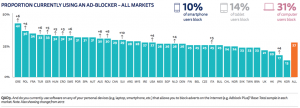Blog
Are We Seeing a Resurgence of Ad Blockers?
2 August 2018
Concerning news for publishers as reports show the use of ad-blockers is on the rise again. After a sustained period of consistency, the latest Reuters Digital News Report identified that there has been an increase in readers using advertising blocking software.
Countries such as Greece are witnessing four in ten readers (42%) using some form of ad blocking software, the greatest amount in the world. Germany (33%) and the United States (27%) have also witnessed large increases, possibly fuelled by the recent privacy concerns coupled with a greater awareness for the technology. Publishers have also seen ad blockers being used alongside privacy browser extensions that allow specific advertisers to be blocked.
The ad blocking culture is showing no sign of slowing down as users become more aware of the issue. 31% of computer users now use ad blocking software globally and we’re seeing increased numbers of smartphone users now blocking ads (10%). For Brazilians, the use of ad-blockers increased by almost a third over the last year as readers seem to be more concerned about security and privacy issues. Countries such as the UK are only seeing 21% of readers using an ad-blocker which is relatively low compared to the majority of the other countries studied.

To combat this publishers must take steps to rethink their digital revenue strategy. Initially analysing the advertisement placements available to provide a better ad experience – too many adverts can frustrate users and drive them to install blocking extensions. More dramatically some publishers are choosing to block content to those who have ad-blocking software enabled, explaining to the reader how vital the ad revenue is.
There are alternatives, earlier this year Google announced a new tool to help publishers tackle ad-blocking. The new tool gives publishers a number of options such as serving a dismissible message that requires ad blocker users to pay after viewing a certain number of articles, or block their access until they turn off their ad blocker or pay for an ad-free experience through another program called Google Contributor. Obviously, Google takes a 10% cut of revenue through this service.
With this news and advertising revenue continuing to fall it’s up to the publisher to think strategically about how they can monetise their content and connect better with their audience. We are witnessing many publishers implementing a subscriptions strategy and locking premium content behind an ad-free paywall. If this is a strategy you would like to explore or interested in finding out more about alternative revenue generating models feel free to get in contact by emailing hello@pagesuite.com.
Sources
http://media.digitalnewsreport.org/wp-content/uploads/2018/06/digital-news-report-2018.pdf?x89475
https://digiday.com/media/dont-forget-ad-blocking-lost-revenue-uk-publishers-rises-63000-year/
https://digiday.com/media/google-expands-tool-publishers-combat-ad-blocking/





